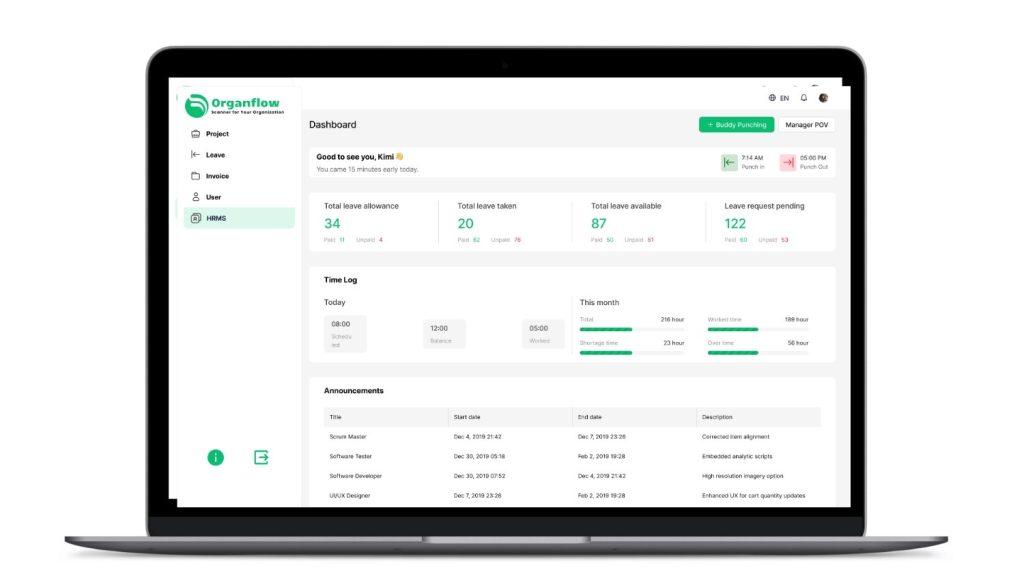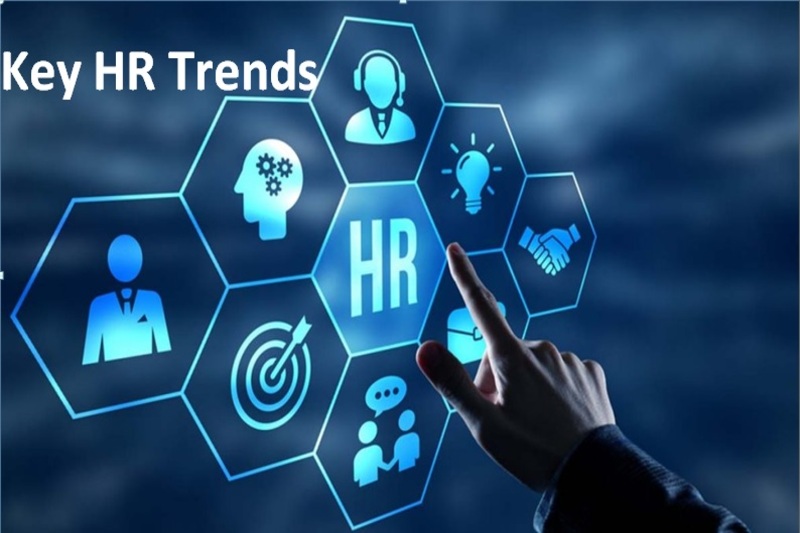HR software, including payroll and human resource management software and system, is constantly evolving to meet the changing needs of businesses, employees, and the company. As we look ahead to 2024, several emerging trends in HR software, including payroll, analytics tools, and key features, are shaping the landscape for companies.
Did you know that by 2024, the HRMS (Human Resource Management System) software market, which includes payroll, people data, and hire solutions, is projected to reach a staggering value of $30.7 billion for enterprise businesses? With such rapid growth and an increasing demand for efficient HR solutions, including talent management, talent acquisition, payroll software, and management software, it’s crucial for businesses to stay ahead of the curve. Whether you’re a small startup or a large enterprise, finding the right HRMS software, such as a payroll management system, can revolutionize how you manage your workforce and company, by effectively organizing and analyzing people data. So let’s dive in and discover the best tools for transforming your HR operations, including management software, analytics, payroll software, and a full human resources management system too.
Emerging Trends in HR Software
HR software, including payroll and human resource management software and system, is constantly evolving to meet the changing needs of businesses, employees, and the company. As we look ahead to 2024, several emerging trends in HR software, including payroll, analytics tools, and key features, are shaping the landscape for companies.
- HR Analytics: The use of analytics in HR software for payroll, company, and team users is becoming increasingly important. Companies are leveraging analytics tools, data, and insights to make informed decisions about their workforce, payroll, and business. With analytics capabilities, HR professionals can gain valuable insights into employee performance, engagement, retention, benefits, payroll, pros cons, and company.
- Technology Integration: The future of HR management lies in seamless integration with technology, including payroll, benefits, company, and team. From applicant tracking systems to performance management tools, companies are adopting software that streamlines processes and improves efficiency in payroll, company benefits, and business. Integrated platforms, including analytics tools and other hr management systems and software, allow for better collaboration between departments and provide a holistic view of employee data, including payroll, for hr teams.
The Impact of AI and Automation on HR Software Development for human resources, employee payroll, employee experience, and employee management.
Artificial Intelligence (AI) and automation are revolutionizing the way HR software, including payroll and other benefits management, is developed and utilized by companies, with the help of analytics tools.
- Enhanced Efficiency: AI-powered algorithms, analytics tools, can automate repetitive tasks such as resume screening or scheduling interviews, freeing up time for HR professionals to focus on strategic initiatives within the business company. This not only improves efficiency in administrative tasks, such as payroll and HR using human resources management systems and software, but also reduces human error. Additionally, analytics tools can further enhance business performance.
- Improved Candidate Experience: AI-driven chatbots can provide real-time assistance to candidates during the application process, answering questions promptly and guiding them through each step. This enhances the overall candidate experience, leading to higher satisfaction rates and increased employer brand reputation.
Criteria for Selecting HR Software
Key Factors to Consider
When selecting HR software solutions for payroll, analytics, and business, there are several key factors that should be taken into consideration each month. These factors, such as payroll, hr analytics, and month, will help businesses make an informed decision and choose the right software that aligns with their needs and requirements.
Features
One of the most important aspects to consider when choosing HR software is the range of features it offers, including payroll, analytics, and business. Businesses should carefully evaluate whether the software includes essential features such as employee self-service, payroll management, time and attendance tracking, benefits administration, performance and human resource management systems, and HR analytics. Having these features, including analytics, can streamline HR processes and improve overall efficiency within the organization.
Pricing
Pricing, analytics, and business are other crucial factors to consider when selecting HR software. Different vendors offer various pricing models such as monthly subscriptions or one-time fees for business and HR analytics. It’s important for businesses to assess their budgetary constraints and determine which pricing model best fits their financial capabilities and incorporates hr analytics. consideration should be given to any additional costs associated with implementation, training, hr analytics, or ongoing support.
User Support
The availability of reliable user support, analytics, and business is vital in ensuring a smooth transition and optimal usage of HR software. Businesses should look for vendors that provide comprehensive customer support through various channels like phone, email, live chat, and analytics. Having access to timely assistance can help resolve any issues or questions that may arise during implementation or daily usage of hr solution.
Integrations
Integrations, including analytics and business, play a significant role in determining how well an HR software solution will work within an existing technology ecosystem. It’s essential for businesses to assess whether the chosen software integrates seamlessly with other tools they currently use such as accounting systems, applicant tracking systems (ATS), and HR analytics. This ensures data consistency across different platforms and eliminates manual data entry tasks in business and HR analytics.
User Reviews
Lastly, considering user reviews and analytics can provide valuable insights into the effectiveness and reliability of different HR software solutions. Reading reviews from other businesses who have already implemented a particular system, including hr analytics, can help identify potential strengths and weaknesses. Taking the time to research and analyze user reviews can assist in making an informed decision.
Essential Features in HRMS Software

Must-Have Features for Modern HRMS Software
There are several essential features, including analytics and HR, that every organization should consider. These features not only streamline HR processes but also contribute to efficient management of employee data, overall productivity, and analytics. Here are some key features to look for:
- Payroll Management: A reliable payroll system, including analytics and HR, is crucial for accurate and timely salary processing. Look for software that offers automated payroll calculations, tax deductions, direct deposit capabilities, and HR.
- Employee Self-Service Tools: Employee self-service tools, including HR functionalities, empower employees by allowing them to access their personal information, submit leave requests, view pay stubs, and update their details independently. This reduces administrative burden on HR staff and improves overall productivity.
- Reporting Capabilities: Effective reporting tools enable HR professionals to generate comprehensive reports on various aspects such as attendance, performance evaluations, training programs, and more. These reports provide valuable insights for strategic decision-making.
- User-Friendly Interface: An intuitive user interface ensures easy navigation and quick adoption of the software by both HR personnel and employees alike.
- Customization Options: Every organization has unique requirements. Look for software that offers customization options so you can tailor it according to your specific needs.
The Significance of Automated Workflows
Automated workflows play a vital role in streamlining HR processes and ensuring efficient management of tasks such as onboarding new employees or conducting performance reviews. By automating these workflows, organizations can eliminate manual errors, reduce paperwork, save time, and enhance overall efficiency.
For example, with an automated workflow in place for employee onboarding, the system can automatically generate offer letters, collect necessary documents electronically through e-signature integration, and assign required trainings—all without any manual intervention.
By incorporating automated workflows into your HRMS software, you can ensure that critical HR processes are executed seamlessly, allowing your HR team to focus on more strategic initiatives rather than getting bogged down by administrative tasks.
HRMS for Various Company Sizes
Small Companies: Streamlined HR Processes
Small businesses often have limited human resources management and a smaller employee base in HR. For these companies, HRMS software provides a streamlined approach to managing HR processes efficiently. With features like employee self-service portals, small companies can empower their employees to handle HR tasks such as requesting time off, accessing pay stubs, and updating personal information. This reduces the administrative burden on HR departments and allows them to focus on more strategic initiatives.
Small businesses benefit from the automation capabilities of HRMS software. Tasks such as payroll processing, benefits administration, and HR can be automated, saving time and reducing the risk of errors. Furthermore, many HRMS solutions offer compliance tools that ensure small businesses stay up-to-date with regulations related to tax filing and reporting.
Medium-Sized Companies: Enhancing Efficiency and Collaboration
Medium-sized companies face unique challenges. As they grow in size, manual processes become more cumbersome and prone to errors in the HR system. This is where an effective HRMS solution becomes invaluable.
For medium-sized companies, scalability is key. They need an HRMS software that can accommodate their growing needs without sacrificing efficiency or increasing costs significantly. Many providers offer different pricing tiers based on company size or employee count, allowing medium-sized businesses to choose a plan that aligns with their budgetary constraints.
Furthermore, collaboration features within an HRMS system are crucial for medium-sized companies with multiple departments or locations. A centralized platform enables seamless communication between teams while ensuring consistent access to important documents, policies, and HR.
Large Enterprises: Customization for Complex Workflows
Large enterprises require robust HR solutions that can handle complex workflows across multiple departments and locations. Customization becomes essential in order to adapt the software according to specific business requirements.
Advanced customization features offered by certain HRMS solutions allow large enterprises to tailor the system based on their unique processes and workflows. This includes configuring approval workflows, defining user roles and permissions, creating custom reports, and managing HR.
Moreover, large enterprises often deal with a high volume of data. HRMS software provides robust analytics capabilities that enable employers to gain insights into their workforce, such as employee turnover rates or performance metrics. These insights help organizations make data-driven decisions and drive strategic initiatives.
Integrating HRMS Seamlessly
Strategies for Seamless Integration
There are several strategies that can help ensure a seamless transition. One important aspect is data migration. It is crucial to carefully plan and execute the transfer of data from the old system to the new one. This includes employee information, payroll data, leave records, HR, and other relevant details.
Another key consideration is system compatibility. Before implementing an HRMS software solution, it is essential to assess whether it will integrate smoothly with your current infrastructure. This involves evaluating factors such as app integrations, unified platform capabilities, interface compatibility, and HR.
To achieve a successful integration, it is advisable to work closely with the HRMS software provider and your IT team. They can collaborate on identifying potential HR issues and finding suitable solutions. Involving employees in the process through training programs can help them adapt quickly to the new system.
Best Practices for a Smooth Transition
To ensure a smooth transition when implementing new HRMS software, there are some best practices that organizations should follow. Firstly, conducting thorough testing before going live is essential. This enables HR to identify any glitches or discrepancies that need fixing before employees start using the system extensively.
Furthermore, ensuring compliance with regulatory requirements global payroll and HR is crucial during this transition period. The HRMS software should have built-in features that facilitate compliance with labor laws and industry regulations related to payroll processing and leave management.
Lastly, providing ongoing support and training for employees, including HR, after implementation is vital for their ease of use with the new system. A user-friendly interface combined with comprehensive training materials will empower employees to make full use of the HRMS software’s capabilities.
Understanding HRMS Software Costs
Breakdown of Cost Components
Understanding the costs involved is crucial. The expenses associated with HRMS software can be broken down into several components.
- Licensing Fees: One of the primary costs is the licensing fee for the software itself. Different providers offer various pricing models, such as one-time purchase or subscription-based plans.
- Implementation and Integration: Implementing and integrating HRMS software requires technical expertise and resources. This process may involve additional costs, including hiring consultants, IT professionals, and HR.
- Customization: Depending on your organization’s specific needs, customization of the HRMS software may be necessary. Customization allows you to tailor the system to align with your unique requirements but can add to the overall cost.
- Training and Support: Proper training for employees on how to use the HRMS software effectively is essential. Ongoing support from the provider may incur additional fees.
Comparison of Pricing Models
Different providers offer a variety of pricing models for their HRMS software solutions. It’s important to compare these models before making a decision:
- Per-User Pricing: Some providers charge based on the number of users accessing the system, hr. This model works well for organizations with a fixed number of employees in hr.
- Tiered Pricing: Other providers offer tiered pricing based on different levels of functionality or features included in each tier.
- Subscription Plans: Many HRMS software providers offer subscription plans that require monthly or annual payments instead of a one-time upfront cost.
Hidden Costs to Watch Out
Investing in an HRMS software solution also involves considering hidden costs that may arise during implementation and beyond:
- Training Expenses: While HR training is crucial for successful adoption, it often incurs additional expenses that should be factored into your budget.
- Data Migration Costs: If you are transitioning from an existing system to a new HRMS software, data migration can be complex and may require additional resources.
Maintenance and Upgrades: Over time, the HRMS software may require regular maintenance and upgrades, which could involve additional costs.
Enhancing Remote Work with HRMS

Supporting Remote Work Environments
With the rise of remote work, HRMS software has become an essential tool for many human capital management and resources teams. This technology enables HR professionals to effectively manage their workforce, regardless of their physical location. By utilizing HRMS software, companies can streamline various HR functions and ensure smooth operations even in a distributed work environment.
One of the key advantages of HRMS software in supporting remote work is its ability to facilitate employee onboarding and management. Through a centralized platform, new employees can complete necessary paperwork electronically and access important company information. This eliminates the need for physical paperwork and allows for a seamless HR onboarding process, regardless of geographical barriers.
HRMS software provides comprehensive features for managing employee payroll and benefits administration remotely. Companies can easily calculate salaries, process payments, and handle benefits enrollment through automated systems. This ensures accurate and efficient HR payroll services without the need for manual intervention or face-to-face interactions.
Facilitating Collaboration and Communication
Effective collaboration among remote teams, including HR, is crucial for maintaining productivity and achieving organizational goals. HRMS software offers features that promote seamless communication between team members dispersed across different locations.
Many modern HRMS solutions provide integrated communication tools such as email and live chat functionalities. These tools enable real-time communication between employees, allowing them to collaborate on projects, seek guidance from colleagues or supervisors, share important updates effortlessly, and access HR resources.
Furthermore, some advanced HRMS platforms offer project management capabilities that allow teams to track progress on tasks collectively. With shared dashboards displaying project timelines, milestones, and individual responsibilities, remote teams can stay aligned on project objectives while working independently from diverse locations.
Ensuring Security in Remote Workforce Management
As companies embrace remote work arrangements more than ever before, ensuring data security and HR becomes paramount. Fortunately, leading HRMS solutions prioritize security measures to safeguard sensitive employee information.
Advanced encryption protocols, including HR, are implemented within these systems to protect employee data from unauthorized access. Role-based access controls are also commonly employed, ensuring that only authorized individuals can view or modify sensitive employee records and HR information.
Moreover, HRMS software often includes robust risk management features to identify and address potential security threats. These solutions can detect anomalies in user behavior and promptly alert HR teams about any suspicious activities. This proactive approach helps prevent data breaches and ensures the integrity of confidential employee information.
Promoting a People-first Culture
Fostering Employee Engagement and Feedback Mechanisms
HRMS software plays a crucial role in fostering a people-first culture within organizations. One of the key aspects of such a culture is employee engagement, which refers to the level of commitment and involvement employees have towards their work and the organization as a whole. HRMS platforms provide various tools and features that facilitate employee engagement, allowing organizations to create an environment where employees feel valued, motivated, and connected.
With HRMS software, companies can implement employee engagement tools such as surveys, polls, and feedback mechanisms. These HR tools enable organizations to gather valuable insights from their employees on various aspects of their work experience. By actively seeking feedback through these platforms, companies can identify areas for improvement and take necessary actions to address concerns or issues raised by employees.
Furthermore, HRMS platforms offer performance management modules that allow managers to set goals, track progress, and provide continuous feedback to their team members. This same performance management module promotes regular communication between managers and employees, enhancing transparency and ensuring alignment with organizational objectives. Such ongoing performance conversations, led by HR, contribute significantly to employee engagement by recognizing achievements, addressing challenges promptly, and providing opportunities for growth.
Personalized Employee Experiences for Positive Workplace Culture
In addition to facilitating employee engagement through feedback mechanisms, HRMS software also enables organizations to deliver personalized employee experiences. A positive workplace culture, as defined by HR, is characterized by an environment where each individual feels valued for their unique contributions.
HRMS platforms offer features like personalized dashboards where employees can access information related to their roles, responsibilities, benefits packages,and career development opportunities tailored specifically for them. This level of personalization not only enhances user experience but also demonstrates that the organization values its employees’ needs and aspirations.
Moreover,collaboration functionalities within HRMS software promote teamwork among colleagues across different departments or locations. Employees can collaborate on projects seamlessly using shared spaces or virtual meeting rooms, fostering a sense of belonging and encouraging cross-functional collaboration.
Adding Organflow to Your HR Toolkit
Streamlining Workflows
Organflow is a powerful tool that can revolutionize your HR processes. With its comprehensive suite of features, it simplifies and automates various tasks, making your workflow more efficient than ever before.
By integrating Organflow into your existing HR toolkit, you gain access to advanced workflows, which allow you to streamline and standardize repetitive tasks. From onboarding new employees to managing leave requests, Organflow provides pre-built HR templates that can be easily customized to fit your organization’s unique needs. This not only saves time but also ensures consistency in the execution of these core HR functions and processes.
Enhanced Analytics and Insights
One of the key benefits of using Organflow is its robust analytics tools. By leveraging data from various HR processes, Organflow generates insightful reports and visualizations that enable you to make data-driven decisions about your workforce. These analytics, including HR data, provide valuable insights into employee performance, engagement levels, and overall organizational health.
With Organflow’s analytics capabilities, you can identify trends, spot areas for improvement, and take proactive measures to address any potential issues before they escalate. This empowers HR professionals with actionable information that helps drive strategic decision-making within the organization.
Seamless Integration with Other HRMS Solutions
Integrating Organflow with other HRMS solutions further enhances its capabilities and expands your overall, workforce planning and management capabilities. By connecting different systems together through APIs or plugins, you can create a seamless flow of information between platforms.
For example, by integrating Organflow with an applicant tracking system (ATS), you can easily track candidates throughout the recruitment process from application submission to hiring decision. Similarly, integrating it with a mobile app allows employees to conveniently access important HR information such as company policies or submit leave requests on-the-go.
Summary
We have also delved into the benefits of integrating HRMS seamlessly into your organization, enhancing remote work capabilities, and promoting a people-first culture. We have introduced Organflow as a valuable addition to your HR toolkit.
By understanding the latest HR software trends and selecting the right HRMS software for your company’s needs, you can streamline your HR processes, improve efficiency, and foster a positive work environment. Integrating HRMS seamlessly allows for better collaboration and communication among employees, regardless of their location. Embracing remote work with HRMS empowers your workforce to thrive in a flexible environment while maintaining productivity. Furthermore, prioritizing a people-first culture through HRMS helps build strong employee relationships and boosts overall engagement.
Take action today by exploring the top HRMS software options for 2024, considering your specific requirements and budget. Implementing the right solution will not only transform your core HR operations but also contribute to the success of your organization as a whole.
Frequently Asked Questions
To select HR software, consider factors like scalability, user-friendliness, integration capabilities, customization options, and data security. Assessing vendor reputation and customer reviews, as well as HR, also helps in making an informed decision.
Look for HR features like employee self-service portals, payroll management, time and attendance tracking, benefits administration, performance management tools, recruitment and onboarding modules. These features streamline and automate HR processes, and improve efficiency.
Yes, HRMS can be tailored to suit companies of various sizes. From small businesses to large enterprises, customizable HR modules allow organizations to adapt the system according to their specific needs.
Integrating HRMS with other systems like payroll or accounting software eliminates manual data entry errors and saves time. It ensures accurate information flow across departments while enhancing overall productivity in the HR department.
HRMS software costs vary based on factors such as the number of users/licenses required and the range of functionalities needed. Prices can range from a few hundred dollars per month for small businesses to thousands of dollars per year for larger organizations.
Join the Revolution
Embrace the future of workflow management with Organflow. Our platform not only simplifies your processes but also unlocks new potentials for your business. With Organflow, achieve a higher level of efficiency, collaboration, and innovation.


